Sales funnel reports come in all shapes and sizes; from basic reports which sum up opportunities, to reports that analyze everything – including the performance of your sales teams.
The sales funnel report you’ll need depends on your business. However, we’ve prepared 7 great sales funnel report examples to lead you in the right direction.
Let’s take a look!
1. Definition and Benefits of a Sales Funnel Report
A sales funnel report is a powerful tool that provides valuable insights into your sales process, helping you analyze and optimize each stage. By understanding how prospects move through your sales funnel, you can identify areas for improvement and make data-driven decisions to enhance your overall sales performance. The benefits of a sales funnel report are numerous:
- Improved Sales Performance: By pinpointing bottlenecks and inefficiencies, you can streamline your sales process and boost your team’s productivity.
- Increased Revenue: Optimizing your sales funnel can lead to higher conversion rates and, ultimately, more revenue.
- Enhanced Customer Engagement: Understanding the customer journey allows you to tailor your approach, resulting in better customer relationships and satisfaction.
- Better Decision-Making: With clear data and insights, you can make informed decisions that drive your business forward.
- Identification of Bottlenecks and Areas for Improvement: A sales funnel report highlights where prospects drop off, enabling you to address issues and improve your funnel’s effectiveness.
In essence, a well-crafted sales funnel report is indispensable for any business looking to refine its sales process and achieve greater success.
2. Understanding the Sales Process
The sales process is a journey that consists of multiple stages, each with its own set of challenges and opportunities. Typically, these stages include:
- Prospecting: Identifying potential customers who might be interested in your product or service.
- Lead Qualification: Determining whether these prospects have the need, budget, and authority to make a purchase.
- Sales Call or Meeting: Engaging with qualified leads to understand their needs and present your solution.
- Proposal: Crafting a tailored proposal that addresses the prospect’s needs and outlines the benefits of your offering.
- Negotiation and Commitment: Discussing terms and addressing any objections to reach a mutual agreement.
- Contract Signing: Finalizing the deal and getting the necessary paperwork signed.
- Post-Purchase: Ensuring customer satisfaction and fostering long-term relationships.
Understanding each stage of the sales process is crucial for creating an effective sales funnel report. By analyzing how prospects move through these stages, you can identify areas for improvement and optimize your sales efforts to achieve better results.
Visually depicted sales funnel stages and opportunities
We’re starting off simple with an example from Insight Squared
Their report example works great if you want to improve your understanding of your funnel, and if you haven’t been tracking a lot so far.
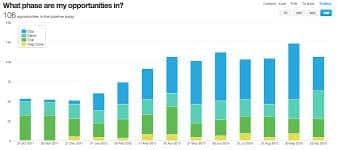
The very least your sales funnel report should contain is:
- Opportunity count
- Sales funnel stages
The benefits of a sales funnel report are numerous: monitoring sales funnel performance is crucial to optimize sales and marketing strategies. Utilizing data analysis and real-time reporting can significantly enhance this performance.
In order to be able to review the information at a glance, you can even put it in a neat graphical format with a chart.
By the time you’ve reviewed it, you’ll know exactly which stage holds the most opportunities. It’s easy to optimize accordingly after that.
2. Revenue matters: highlight it with your sales funnel report
While opportunity counts broken down by stages matter, what matters most is the end goal: your revenue, and how you earn it.
Understanding each stage of the sales process is crucial for creating an effective sales funnel report. A company funnel can help monitor the progression of contacts and deals through these stages, identifying drop-off points and evaluating the effectiveness of each stage.
Our next example from Gary Smith depicts a sales funnel report that incorporates:
- Sum of amount
- Stages
- Close dates

When you create such a report, you can easily see the revenue you are bringing in (or failing to bring in) at each stage.
Additionally, you’ll be able to make more accurate financial projections when you know how much money you’ll likely earn in a given time.
Creating such a report won’t take up too much of your time. However, once you’re done, you’ll know exactly what to do next.
3. Funnel leakage
When you’re struggling with funnel leakage, the most important thing is defining where the leakage occurs.
However, the main prerequisite for this is tracking your sales funnel stages and revenue generated through each.
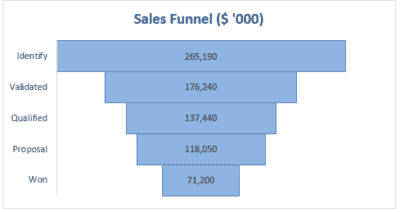
This Trump Excel sales funnel report example sums up everything you need to know about your leakage.
It shows you exactly how much money leaks through your funnel – stage by stage. In this particular example, we can see that the most notable decrease is between the identification and qualification stages.
They may be different for your sales team. However, you need to see the hole to plug the leak.
4. The fluidity of your sales funnel
In many ways, a sales funnel is like a clock; all the mechanisms have to work seamlessly in order to tell you the time.
If your customers feel like they are naturally progressing through each stage (and if your chosen methods are efficient), you will be able to gauge it from a phase-by-phase funnel conversion report.

The folks at Chandoo are using the two major elements to every sales funnel report (the value of opportunities/opportunities count, and the phases). However, they are visualizing the phases, as well as adding a phase-by-phase conversion rate.
This way, they can see that the worst performer is the closing stage; from which only 48% of prospects successfully convert to customers.
Sales team (member) performance
In addition to monitoring your overall results, you can also use a sales funnel report to monitor the performance of your sales teams.
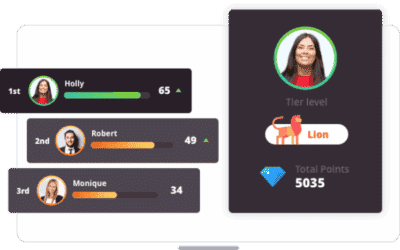
Spinify dashboards not only motivate employees; they track their performance and progress.
After setting the KPIs that matter most to your company and your team, you and individual team members will get automatic achievement notifications whenever they perform actions which bring you closer to your target.
This way, you aren’t just getting a sales funnel report. You’re actively improving the figures you’ll see on it.
6. Holistic view of your sales performance
If you are ready to take your sales funnel report game to the next level, you’ll need an executive sales funnel dashboard.
Not only will it include opportunities and stages; it should also include team performance, closed deals, and so much more.
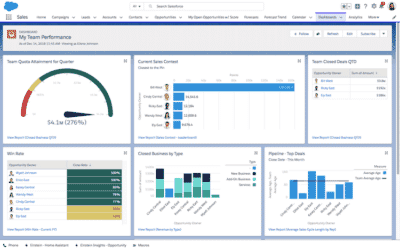
This Salesforce report example may seem complicated, but it is actually allowing you to understand:
- The types of deals you’re closing at certain stages
- The performance of your sales reps
- Key clients you should focus on
9. Sales Pipeline Management
Sales pipeline management is the backbone of a successful sales strategy. It involves organizing and managing customer data, tracking interactions, and monitoring the progress of deals through each stage of the sales process. Effective sales pipeline management ensures that your sales pipeline remains healthy and that your sales goals are met.
Using tools and software to manage your sales pipeline allows you to:
- Track Deals: Keep an eye on where each deal stands in the sales process.
- Monitor Interactions: Record and analyze every interaction with prospects to understand their needs and preferences.
- Propel Deals Forward: Identify and address any obstacles that might be slowing down the progress of deals.
- Achieve Sales Goals: Stay on top of your sales targets and ensure that your team is on track to meet them.
By maintaining a well-organized sales pipeline, you can ensure that your sales process runs smoothly and that your team is equipped to close deals efficiently.
10. Sales Funnel Report Tools and Software
Creating and managing sales funnel reports is made easier with the right tools and software. Here are some popular options that can help you track sales performance and make data-driven decisions:
- HubSpot: A comprehensive CRM platform that offers robust sales analytics and reporting features.
- Google Analytics: While primarily a web analytics tool, it can provide valuable insights into your marketing funnel and lead generation efforts.
- Salesforce: A powerful CRM tool that offers extensive sales pipeline management and reporting capabilities.
- Plecto: A performance dashboard tool that helps visualize sales data and track team performance.
- Nutshell: A user-friendly CRM that offers sales automation, pipeline management, and reporting features.
These tools provide a range of features, including pipeline management, sales analytics, communication and collaboration tools, and sales enablement tools. By leveraging these tools, businesses can create and manage effective sales funnel reports, track sales performance, and make informed decisions to drive success.
By integrating these new sections, the article will provide a comprehensive guide to understanding and utilizing sales funnel reports, helping businesses optimize their sales processes and achieve their goals.
7. Double-down on what works
Finally, a sales funnel report shouldn’t just help you identify what’s wrong.
It should also help you see and repeat what you’re doing right; be that certain actions or phases that simply win customers over.
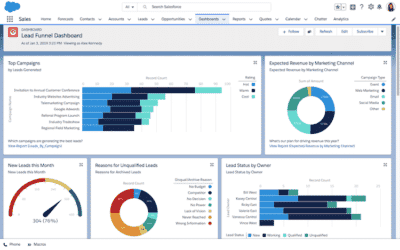
This Salesforce example is particularly good for getting a detailed look at every phase of your sales funnel.
With a report like this, you’ll be able to see which actions within each stage are driving the most success. And when you can see it, you can repeat it.
Unlocking Success: The Power of Sales Funnel Reports
In conclusion, implementing effective sales funnel reports is crucial for understanding and optimizing the sales process. By utilizing visually engaging charts, tracking revenue and conversion rates, identifying funnel leaks, and monitoring team performance, businesses can gain valuable insights to drive better outcomes. Comprehensive dashboards and reports highlighting successful actions empower teams to replicate winning strategies and make informed decisions. With these tools, businesses can enhance efficiency, improve performance, and ultimately maximize revenue potential.
It’s time to take action!
By embracing sales funnel reports, companies can transform their sales strategies and processes. These reports not only provide a clear picture of each stage of the sales funnel but also help in pinpointing areas that require attention. As businesses delve deeper into the data, they can uncover trends and patterns that were previously unnoticed. This data-driven approach enables sales teams to focus their efforts more effectively, ensuring that resources are allocated efficiently to areas with the highest potential for conversion.

Moreover, sales funnel reports can be instrumental in aligning marketing and sales efforts. By analyzing the flow of leads through the funnel, marketing teams can adjust their strategies to generate more qualified leads, ultimately leading to a more seamless transition from marketing to sales. This alignment ensures that both teams are working towards common goals, enhancing the overall customer journey and boosting customer lifetime value.
In addition, sales funnel reports can aid in forecasting and planning. By understanding historical data and current trends, businesses can make more accurate predictions about future sales performance. This foresight allows companies to set realistic targets, plan for growth, and allocate resources strategically.
In a rapidly changing business environment, staying ahead of the competition is vital. Sales funnel reports offer a competitive edge by providing the insights needed to adapt and innovate. As businesses continue to evolve, those who leverage the power of sales funnel reports will be better positioned to succeed and thrive in the marketplace.
So, don’t wait any longer. Start integrating sales funnel reports into your business strategy today and unlock the full potential of your sales process!



